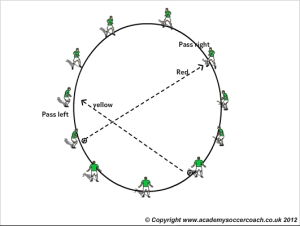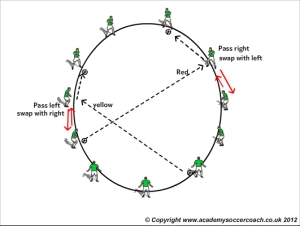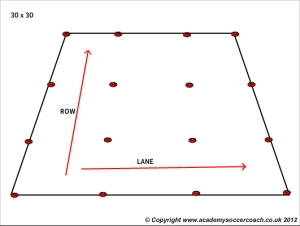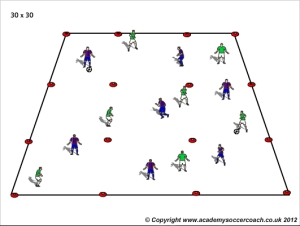Two passing practices
In the summer I returned to Belfast to refresh my coaching licence, and there I saw some sessions that were based on improving awareness, passing, support etc
I recently used two of them with the U19 group I work with, adapted to suit them. They are challenging as they require the players to think, to know what’s going on around them, as well as focus on the technical side of their play. These two practices also encourage communucation between the players, and you will find players will start telling others around them where they should be and where they should pass the ball.
As a coach please be patient initially in these sort of practices, it will take a bit of time for the players to become more fluent, but it’s great to watch when they do. I believe in challenging players, making training interesting/different for them. Players will not progress if training is easy. I also find players find many passing practices boring, so I think these two practices are examples of the opposite. For me, they’re perfect to use in your warm up
Practice 1
Spread your players around the centre circle. You’ll need two different coloured balls (I use red and yellow).Quite simply if a player is passed the red ball, he must set the player on his right who then passes across the circle to another player, who again sets the player to his right. If a player is passed the yellow ball, he must then set it to the player on the left who then passes across the circle.
To progress this now, add a condition that if the player receives the red ball, after he has set the ball to the right, then he must swap places with the player on his left. If the player receives the yellow ball, he will continue to set the ball left, but swap places with the player on the right
Initially the progression can be a bit chaotic, but the players will become more fluent quickly, and you’ll notice the huge change in communication too. On the technical side, both the longer passes across the circle and the set to the player next to them (can they do it two touch, and then one touch?) should be of a good quality (weight, accuracy). I find here that bad touches/passes from players tend to be as a result from using the outside of the boot.
Practice 2
When I did this recently, I set up a 30×30 pitch with cones across the pitch to create rows and lanes.
I had 14 players (two teams of 7) with one ball per team. Players are numbered 1 to 7. PLayer 1 passes to player 2, 2 to 3 and so on until 7 has the ball, and he will pass to 1. However, the player on the ball is not allowed to pass the ball on if the next player is in the same row or lane. In the diagram below, the player on the ball cannot pass to the next player should he be player 1 or 2, but he can pass to him if he is the circled player as he is not in the same row or lane
With two teams passing two balls around the area, again it will initially be fairly chaotic.
However, within 10 minutes players will start to figure out that they need to come short to support the player on the ball when it’s their turn to receive it. There will be poor longer passes, but this part of the players finding the solution. They’ll start to look around them to be able know where the other team are so they don’t bump into each other, plus they’ll start to tell the next player where to be.
One of the main things to coach here is the players first touch. That first touch should be into space (which they will start to recognise as a result of having to look around) or can it be into another row or lane, if the next pass is to a player who is in the same row or lane.
When the players become more fluent, then you can limit it to two touch, for no other reason than to speed up their thought process of what’s around them. If I was to do this with a younger age group then I wouldn’t limit them to two touch for obvious reasons. Like all sessions, just adapt it to suit your players (including pitch size depending on age, ability, numbers etc)
The beauty of these practices is that the players will find the solutions quickly themselves. They’ll start giving each other better in game information whilst having to focus on their technical ability.




